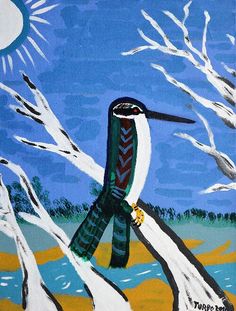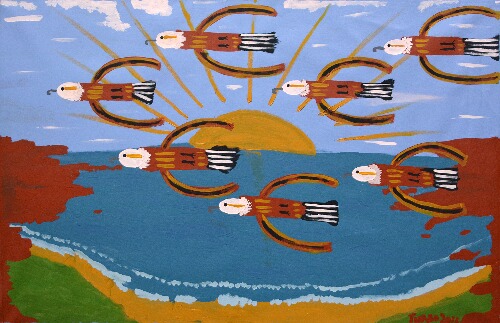From the riverbank in Mildura, to the streets of Melbourne, to the world’s most prestigious art galleries: this is the story of Trevor ‘Turbo’ Brown.

Trevor Brown was born in Mildura in 1967. An Aboriginal man, from the Latje Latje tribe, he was abandoned by his family at a young age, and grew up on streets.
When he was still a child, he started camping on the banks of the Murray River, which ran through the centre of town. He lived by himself, making friends with the stray animals that also lived on the riverbank. In the winter, he sometimes slept with packs of wild dogs, to keep warm.
Trevor was born with both a cleft palette and an intellectual disability, barriers that made it hard for him to express himself. Sleeping outside, living rough, lacking human connections, as a teenager he descended into alcoholism, stealing to pay for his habit.
But, he was about to catch a break.

A local police sergeant had become aware of Trevor’s situation, and decided to take action.
Rather than arrest him for his thieving, he referred him to Uncle Herb Patten and his wife, Aunty Lorraine Bunta Patten; an aboriginal couple who ran a youth hostel in Brunswick, in inner city Melbourne. Herb and his wife had come to Mildura to see about opening a second hostel to help disadvantaged youth in the town.
Instead, they took Trevor Brown back to Melbourne with them.

The culture shock was pronounced.
‘It was a big challenge. He had never had a hot bath. He wasn’t toilet trained.’
- Uncle Herb Patten
The big city also provided a raft of temptations for an impressionable teenager. Trevor fell in with groups of local street kids and would hang out with them, sometimes disappearing for a few days or a week.
He had never been exposed to much popular music before, and quickly developed a love for rap, and electronic music. His new friends would play tunes on portable cassette decks and would breakdance on the street for money, which Trevor was an enthusiastic participant in.
His frenetic dancing style provided him with a nickname: ‘Turbo’.

Uncle Herb and Aunty Bunta rode these bumps with equanimity.
They provided Trevor with a stable home, when he was home, and made sure he ate, and stayed healthy. They also arranged for his cleft palette to be repaired via cosmetic surgery, which made it easier for him to communicate.
One thing that had not changed from his earlier life, was Trevor’s love of animals. He would bring stray dogs home, one time appearing with four dogs at once, and would spend his free time playing with them. Sometimes he sketched pictures of them.
He continued to live in the hostel, even as he left his teen years behind, and matured into an adult.
Time passed.

In 2000, Uncle Herb and Aunty Bunta lost their government grant, which had funded the hostel. Looking for a change, they both enrolled in RMIT. And they encouraged Turbo to do the same.
In 2001, he began a Diploma of Visual Arts at the school. It was to be a life changing experience.
‘I remember him coming in to the first class, and starting to paint. And within 20 minutes, every other student was standing around, watching him.’
- Former RMIT Classmate
Using a bright colour palette, Turbo used bold, plain visual language to paint large scale pictures, nearly always of animals.
These were the animals he remembered from his troubled youth; his friends from the riverbank. Many of them were of dingoes, which he saw as his spirit animal, a metaphoric representation of himself.
He also painted a whole series of his favourite stray dog from Uncle Herb’s place, who he called ‘Auggie Dauggie’. Auggie Dauggie followed Turbo everywhere, and the two slept together in his bed each night.

Turbo liked to paint outside. He especially enjoyed working in the sun, feeling the warmth on his body, and watching the raw sunlight liven up his colours.
He held the brush in an unorthodox style, and worked quickly; a full canvas was often finished in an hour.
At the end of his degree, in 2005, Turbo contributed works to the end of year graduate art show. His paintings sold immediately.
The following year he had his first solo exhibition, at the Koorie Heritage trust in Federation Square. This was an even bigger success; all of the works in the show were sold within 25 minutes on opening night, followed by rave reviews in the local press.
A major artistic talent had arrived.

But despite his burgeoning success, Turbo would never put all of his demons behind him.
He could be moody and irascible.
He was on a variety of medication to help with his mental health problems, but would frequently forget to take them; sometimes disappearing for a few days, or wandering the streets of Brunswick and Collingwood, ranting to himself.
His sold out first show had left him with a lump sum of about $30 000, a large amount for someone living on a disability support pension. Within a couple of months it was all gone; most of it given away, a significant amount dropped into pokie machines in pubs across the inner north.
Outside of his teen years, Turbo didn’t drink or do drugs, but would remain a problem gambler, whenever he came into significant amounts of money.
But he was viewed by the local community, the art scene and the wider community, as a gentle soul, someone with a kind heart, an innocent.

As he rose to prominence in the local art scene, Turbo acquired a manager.
Nick Kreisler was a middle aged Kiwi, who moved to Melbourne in 2007. A former musician and freelance photographer, Kreisler established a print studio and art gallery in an old hat factory, on Victoria Street in Collingwood.
He encountered Turbo around the time of his early shows, and the pair hit it off.
Kreisler entered an agreement to represent the artist, and would also provide him with studio space, to paint. Only, Turbo’s methods were a little different to most artists:
‘Turbo painted in the back alley behind Bunning’s warehouse, just with his paints on top of wheelie bins, and an old canvas on another wheelie bin.
And it looked like the scene of a massacre, with paint splattered everywhere.’
- Nick Kreisler

Turbo was a prolific artist.
He painted nearly every day, and completed his works quickly, instinctively. If he was between shows and short of cash, he would take his finished paintings, often still wet, down to a Brunswick street corner and try to flog them to passers-by, for fifty or a hundred bucks.
For anyone who mistook him for a local lunatic, he had a spiel:
‘I’m a famous artist. Very big overseas. Very famous. No one knows me here. My name is Turbo, go look me up on Google.’
People would, and would be amazed to find that he really was a well known figure in the art scene, and that the fifty dollar painting they had just brought was worth 20 times as much.
But the truth was nearly out. Turbo was about to become famous.

After being a finalist twice before, in March 2012 Turbo won the Deadly Award, for Indigenous Art in Victoria, the most prestigious Indigenous art prize in the state.
The award had a cash prize of $25 000, and dramatically raised his profile.
His works were now being sold overseas, and he was included in group exhibitions at both the Louvre in Paris, and the Tate Modern in London.
Turbo capped a big year with a hugely popular solo show at the Bunjilaka Cultural Centre, at the Victorian Museum. Called ‘Last Man Standing’ this featured 13 specially commissioned new canvas’, along with a collection of earlier works, and ran for 7 months.
It was eventually seen by more than a million people.

Despite his success, Turbo remained a shy figure, and wary of crowds.
He had to be convinced to show up to accept his Deadly Award, and he never attended his opening nights.
‘We’ve had him a couple of times in exhibitions, and he would come, but he wouldn’t come for the opening. It was too much, he didn’t like lots of people.
But he would come when it was quiet. He’d just pop past every day, and he’d come in, and have a little chat to the painting. It was like he was talking to the characters within the painting.’
- Kimba Thompson, curator at ‘Blak Dot’ gallery, Melbourne

I am at the NGV, in Fed Square, the first time I see one of Turbo's paintings.
It is a very bright picture of some sort of animal, quite orange, very big. The corridor between me and it has been darkened for dramatic effect, and this heightens the liveliness.
I walk down to it. Feel drawn to it. It is completely mesmerising.
The painting is of a dog, staring back at you, with its fangs drawn. It has been depicted simply, with a few broad paintbrush strokes, and slabs of bright colour.
But I can feel an enormous pull of something behind this. Clearly the artist felt passionately about the subject, and I can feel it too.
I stare at the painting for a long time. Lots of people come and go, many of them join me. They whisper and point, and say things like, ‘amazing’. It is a nice feeling, as we share it separately, but together.
The picture is called ‘I am the Dingo Spirit’, by Trevor ‘Turbo’ Brown.




Trevor brown died of natural causes in January 2017. He was 49 years old.

